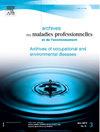Évaluation de l’exposition au chrome hexavalent à bord d’un sous-marin nucléaire
IF 0.3
4区 医学
Q4 PUBLIC, ENVIRONMENTAL & OCCUPATIONAL HEALTH
Archives Des Maladies Professionnelles Et De L Environnement
Pub Date : 2025-02-01
DOI:10.1016/j.admp.2024.102806
引用次数: 0
Abstract
Introduction
Du chrome total a été détecté dans l’atmosphère d’un sous-marin nucléaire lanceur d’engins en mission (0,002 mg.m-3) lors d’une campagne de mesures exploratoires. Le chrome VI, toxique, a une valeur limite d’exposition professionnelle contraignante (0,001 mg.m-3).
Objectif
Compte tenu d’une exposition respiratoire continue pendant 90 jours, nous présentons ici une démarche d’évaluation de l’exposition. La découverte de chrome total semble liée à une contamination par une activité industrielle lors de la phase d’entretien à quai mais aucune source de pollution n’a été identifiée a posteriori. Une évaluation théorique des indicateurs biologiques d’exposition dans un contexte d’exposition respiratoire permanente, d’après le modèle de Mutti, estime que la chromurie serait supérieure aux valeurs limites biologiques si le chrome atmosphérique détecté était du chrome VI.
Méthode
Ce constat nous a incité à coupler métrologie et biométrologie pour identifier des sous-groupes de marins susceptible d’être particulièrement exposés. L’objectif est d’apporter une réponse rapide à l’employeur quant à la stratégie de prévention à adopter autour de la démarche ALARA. Des prélèvements atmosphériques sur filtres ont été réalisés en patrouille sur le sous-marin identifié et une recherche de chrome urinaire total a été menée avant le départ puis couplée aux prélèvements atmosphériques au sein d’un groupe témoin de 15 marins appartenant à l’équipage.
Résultats
Les prélèvements atmosphériques n’ont pas détecté de chrome VI et les résultats urinaires sont tous inférieurs à la limite de quantification pour le chrome urinaire total.
Conclusion
Ces résultats de métrologie et de biométrologie laissent supposer que le groupe sentinelle n’a pas été contaminé par du Cr VI.
Introduction
Unspecified chromium was found in the atmosphere of a French nuclear-powered ballistic missile submarine (SSBN) during a deployment (0.002 mg.m-3) during a measurement campaign. Chromium VI is highly toxic and its occupational exposure limit value is low (0.001 mg.m-3).
Objective
Because of the specific airborne exposure aboard submarine, we aim to discuss human exposition assessment relative to chromium in SSBN. The first sampling campaign suggested the occurrence of airborne pollution by a dockside industrial activity during the submarine maintenance phase. No source of pollution has been identified retrospectively. Nevertheless, an assessment of biological exposure indicators based on Mutti's model, estimates that chromuria would be above biological limit values if the atmospheric chromium detected was chromium VI in this context of continuous airborne exposure.
Method
This observation prompted us to combine metrology and biometrology to quickly propose a prevention strategy based on ALARA principle in this particular professional context. Atmospheric samples were collected several times during a deployment aboard the submarine where chromium dust was found. Urinary samples to search unspecified chromium were also collected among a homogeneous exposure group of 15 crewmen, prior to departure and then combined with atmospheric sampling.
Results
Atmospheric samples did not detect chromium VI. Urinary results were below the limit of quantification for urinary chromium.
Conclusion
These metrological and biometric results suggest that the sentinel group was not contaminated by Cr VI.
核潜艇上六价铬暴露评估
在一次探索性测量活动中,在一艘核潜艇的大气中检测到总铬(0.002 mg.m-3)。六价铬是一种有毒物质,具有强制性的职业接触限值(0.001 mg.m-3)。考虑到持续90天的呼吸暴露,这里提出了一种评估暴露的方法。全铬的发现似乎与码头维护期间的工业活动污染有关,但随后没有确定污染源。理论考核指标的呼吸暴露生物暴露在一个永久性Mutti模式后,认为chromurie是高于限值的生物若发现空气中的铬铬VI.MéthodeCe却促使我们把认知的计量和海洋的识别子可能特别容易发生。其目的是为雇主提供有关ALARA方法的预防策略的快速反应。在对已确认的潜艇进行巡逻时,对大气过滤器进行了取样,并在出发前对15名船员进行了尿液中总铬的取样,同时对大气进行了取样。大气取样未检测到六价铬,尿液结果均低于总尿素铬量化限值。结论:在一次测量活动中,在一艘法国核动力弹道导弹潜艇(SSBN)的大气中发现了未指定的铬(0.002 mg.m-3)。六价铬具有剧毒,其职业暴露限值较低(0.001 mg.m-3)。由于潜艇上特定的空气暴露,我们的目的是讨论人类对SSBN中铬的暴露评估。第一次采样活动表明,在潜艇维修阶段,船坞一侧的工业活动造成了空气污染。回顾性没有确定污染源。然而,根据Mutti的模型对生物暴露指标进行的评估估计,如果在这种持续空气暴露的情况下检测到的大气铬是六价铬,则铬将超过生物限值。这一发现促使我们将计量学和生物计量学结合起来,在这一特殊的专业背景下,根据ALARA原则迅速提出一种预防策略。在发现铬尘的潜艇上进行部署期间,多次收集了大气样本。此外,还收集了15名机组人员的同质暴露组的尿液样本,以寻找未指定的铬,然后在出发前与大气样本结合。结果:大气样品未检测到六价铬。这些计量和生物特征的结果表明,哨兵组没有受到Cr VI的污染。
本文章由计算机程序翻译,如有差异,请以英文原文为准。
求助全文
约1分钟内获得全文
求助全文
来源期刊

Archives Des Maladies Professionnelles Et De L Environnement
医学-公共卫生、环境卫生与职业卫生
CiteScore
0.40
自引率
50.00%
发文量
185
审稿时长
50 days
期刊介绍:
The Archives of Occupational and Environmental Diseases (Archives des maladies professionnelles et de l''environnement) publish scientific original articles in the form of memoirs, developments and general health reviews. The journal is a reliable source of information, which lets you gain additional knowledge or update your knowledge of basic or original issues.
The section Continuous professional development focuses on a major issue and gives you the tools to optimize your practice. The content is divided in 3 parts: Reading Test, Answer to the Reading Test and Scientific Press Review, which let you share the analysis, by the editorial board, of articles from major English-language journals.
The section Legal Environment discusses an environmental culture. The section Letter to the editor keeps you informed about the press review; the Legislation, with the latest regulations published in the Official Journal; and the agenda of the meetings and the Congress, the questions–answers, etc. The Archives of Occupational and Environmental Diseases include all the scientific communications of the French occupational health societies, of which they are the official journal.
 求助内容:
求助内容: 应助结果提醒方式:
应助结果提醒方式:


